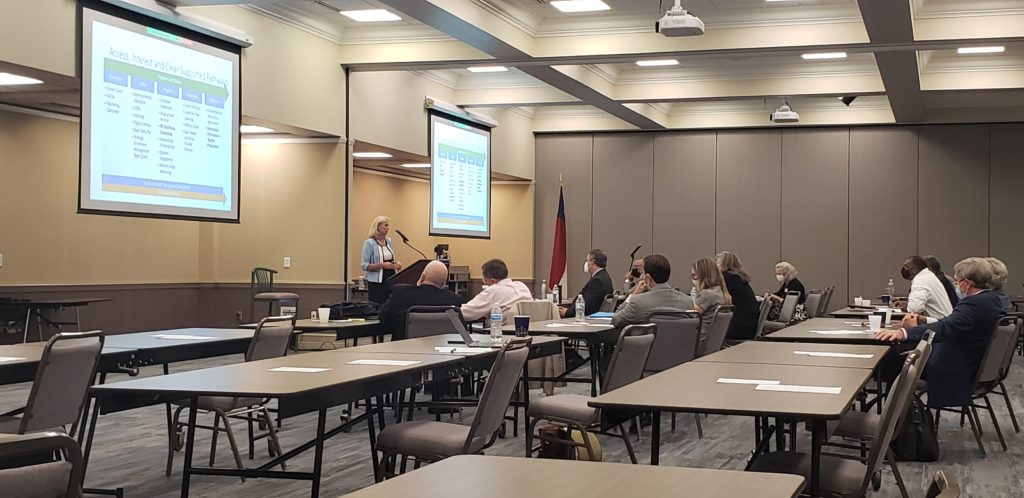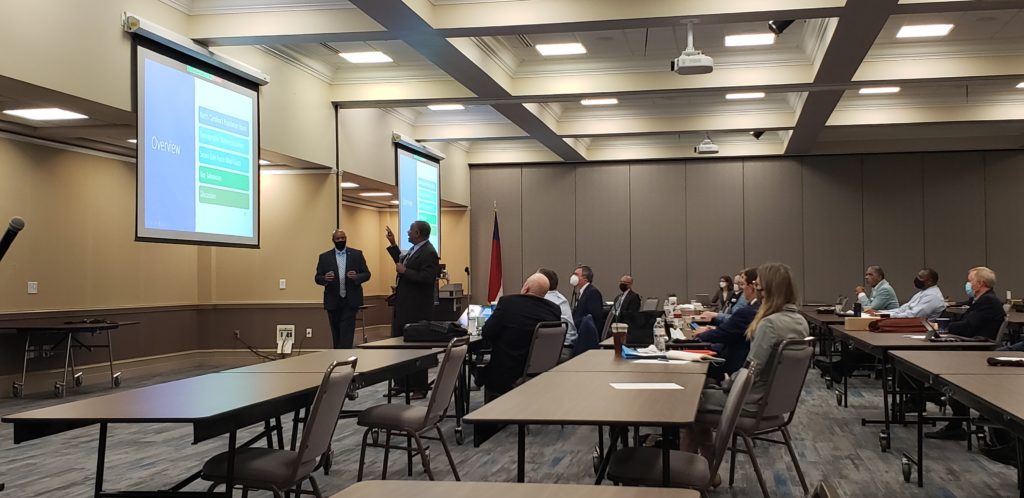|
|
The State Board of Community Colleges spent Sept. 15-16 laying out their vision for the system’s future. And now there’s a new leader in charge of seeing it through.
Burr Sullivan was elected as the new chair of the Board on Friday. In a 11-8 vote, members chose him over Lisa Estep, who was recently reappointed to the Board. Sullivan will finish out the term of former chair Breeden Blackwell, whose tenure on the Board ended this month.
Sullivan, a retired business owner, promised to bring that experience to his leadership. He recognized the challenges that many colleges are facing now and said he will call on the Board to use their “best thinking.”
“This is a very humbling experience to have a chance to lead a group of people as talented as the people in this room,” he said.
One of the Board’s main goals over the next year is to finalize its new strategic plan. The plan will outline the Board’s and system’s goals for the next few years.
The majority of this month’s meeting was spent discussing where the system is now, how it can get where Board members want it to be, and potential challenges.
The goal: to be the first choice in affordability and accessibility for North Carolina students, a model for diversity, and an economic driver for the state.

In North Carolina, just shy of two-thirds of the population over 25 has at least some college. But when you break that down by county, 78 counties don’t meet that threshold. The gaps widen when race is taken into account.
And enrollment at the state’s community colleges has been declining for more than a decade. For the students who are enrolled, they only complete about 6 credit hours on average each semester.
For Black students, that number is just 4.4 credits.
You can dive deeper into these numbers below.
In addition to hearing this status update about the system, the Board also was briefed on demographic trends in the state that should inform their thinking.
Census data that came out this year show that North Carolina’s population continues to grow. However, almost all of that growth has been concentrated in the urban and suburban counties in the state, with rural counties experiencing population declines.
And though the state has been growing, that trend is slowing. Dr. James Johnson, a UNC professor who presented to the Board, said some of the reasons include the rising costs of housing and child care.

These are some of the realities system staff explained to the Board this week. And while these numbers outline some challenges facing both the system and the state, the Board also saw them as a reminder of their purpose.
“This is not the time to bury your head in the sand,” Johnson cautioned the Board, adding that civil servants that these colleges can educate are the lifeblood of a community.
The counties with a declining population largely match the places where enrollment has also been declining, so the Board is asking itself how community colleges can evolve to meet these new needs.

To conclude the first day, the Board did a SWOT (Strengths, Weaknesses, Opportunities, Threats) analysis for the system. Here are the highlights:
Strengths: staff and faculty, economic opportunities in parts of the state, strength of rural communities
Weaknesses: funding/enrollment/retention, lack of an engagement strategy, understanding the root cause of these trends, leadership transitions, lack of data analysis
Opportunities: federal COVID-19 funds, collaboration with partners, energy of the Board, private sector partnerships
Threats: decreases in enrollment, funding, faculty retention and recruitment, salaries, four-year and for-profit institutions competing for space
The process of formulating the strategic plan is expected to last about a year. In the meantime, system staff plan to engage students, faculty, and staff at colleges over the next few months. Details are still in the works, so stay tuned.
Career Coach Program, legislative update, diversity report
During discussions on retaining employees and growing the system, it’s hard to forget the fact that the state still hasn’t passed a budget.
Bill McBrayer, chair of the Legislative Affairs Committee, told the Board he is optimistic that the House and Senate will release a compromise agreement before October. That agreement will hopefully include raises for community college faculty and staff, he said.
The House budget proposal had a 7% raise for faculty and 4% raise for staff, while the Senate proposal had 3% raises for all state employees.
The Board also discussed the progress of the Career Coach Program, which places career coaches in high schools to serve as counselors to students. These coaches talk to students about their career goals and steer them toward community college when applicable.
The program’s annual report is due to the Joint Legislative Education Oversight Committee this year.
There are 84 coaches across the state serving more than 27,000 students in 57 districts. Last year, the program saw its largest allocation yet from the legislature at $4.5 million.
“This is a very good investment for the state of North Carolina,” Sullivan said, saying the Board needs to lobby to increase the number of coaches.
North Carolina Community College System President Thomas Stith told the Board that the System Advisory Council concluded its diversity, equity, and inclusion report. The report, which the Board will review in full at its meeting next month, has three recommendations:
- Eliminate the Residency Determination Service requirement
- Add DEI language to the State Board code
- Eliminate student debt related to small fees and charges
Senate Bill 421, which expands in-state tuition eligibility for certain students who can’t use the RDS system, became law earlier this month.
The Board will have its next meeting Oct. 14-15 in Raleigh.
Recommended reading




